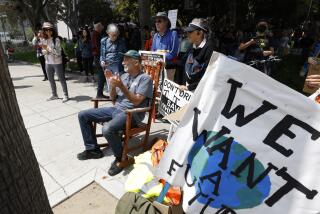COLUMN ONE : Women’s New Push for Health : Stepped-up activism nationwide is focusing on breast and ovarian cancer. Groups want improved insurance coverage and more funds for research.
Ellen Hobbs’ activism began with a lump in her armpit. She noticed it in the mirror last October after an aerobics class. A mammogram failed to find anything, so Hobbs had a biopsy. At 35, with four children, she was diagnosed as having metastatic breast cancer.
Hobbs’ oncologist gave her a 90% chance of dying within three to five years. The cancer was too advanced for traditional chemotherapy to help. An experimental treatment might raise her chances, but Hobbs’ health insurance company would not cover it and she could not afford it.
“I could see there was something wrong with this picture: The only treatment you can have doesn’t work,” Hobbs, a nurse in Sacramento, said recently. So she decided to stage a protest march: “I called the state police to make reservations.”
Now, Hobbs, whose previous political activism began and ended with the presidential candidacy of George S. McGovern in 1972, is the driving force behind one of a growing number of grass-roots groups springing up nationwide to demand greater attention to women’s health.
In Boston, activists rallied on Valentine’s Day for breast cancer research. In New York City, women marched on April Fool’s Day to protest the limits of health insurance coverage. In Sacramento, Hobbs’ demonstration is set for Mother’s Day on the Capitol steps.
In San Francisco, women are studying the tactics of the AIDS activist group, ACT UP. They have started a newsletter modeled on AIDS treatment newsletters. Some stamp their mail with the slogan, “Forty-four thousand die of breast cancer each year. Why?”
Women’s health groups are not new. Over the past 20 years, groups have formed around issues ranging from hysterectomy to endometriosis. But the new groups, devoted primarily to breast and ovarian cancer, differ from many of their predecessors in being overtly political.
Behind their upsurge during the past 18 months is the remarkable success of AIDS patient advocacy--in influencing the direction and pace of biomedical research, in increasing public funding for research and treatment, and in shaping the way the public views AIDS.
Also fueling the new movement are the rising rate of breast cancer, now the most commonly diagnosed cancer, with 175,000 new cases in women expected this year, and the fact that women who were politically active in the 1960s have reached an age that is hard hit.
The new activists’ ambitions are not unfamiliar. Like AIDS activists, they want more and better research, improved insurance coverage and access to care, and greater sensitivity on the part of organized medicine and the public to their needs.
In particular, many want greater priority given to breast cancer. Too little is known about the disease and too little is spent on learning more, they say. There is no known cause and no cure. Methods of early detection, such as mammography, are far from infallible, they say.
The new groups’ emergence has left some observers worried. They fear a proliferation of special-interest health groups, compelled by the federal budget process to wrangle with each other over what many believe is an inadequate pool of money for research.
“It isn’t going to do any good to have AIDS, cancer, Alzheimer’s and other diseases fighting with each other,” said John James, who edits an AIDS treatment newsletter in San Francisco. “We need more and better research on the whole.”
“We are not putting nearly enough resources into biomedical research,” said Dr. John Laszlo of the American Cancer Society. “But I don’t think it’s productive to run our entire enterprise of biomedical research based on people picketing for the disease of the month.”
Dr. Hoda Anton-Culver, a UC Irvine professor of environmental toxicology who directs Orange County’s Cancer Surveillance program, also questioned whether confrontational women’s health groups were needed.
But she agreed that more money should be spent for research on women’s health. For the third year in a row, Anton-Culver and other UCI researchers are seeking a federal grant to look at the rising rate of lung cancer in women. The grant was not funded in previous years.
In nearly every case, the new groups have risen out of women’s experiences with the medical system--a physician’s failure to diagnose accurately the cause of a lump, a mammogram that was wrong, a lack of information about treatment choices, and a shortage of alternatives.
Elenore Pred, found a lump in her breast in her mid-40s. A surgeon decided that it was scar tissue and sent her home without a biopsy. When she returned two years later with the same lump, the cancer had spread to her lymph nodes.
Pred had a mastectomy in 1981, then went on with her life. After five years, she assumed she was cured. She went off to Morocco with the Peace Corps. Then a lump surfaced above her collarbone. The cancer had spread to her bones.
“I certainly wasn’t told (after the first surgery) that I had very little possibility of living long,” said Pred, 57. “When I got to the five-year mark, I said I’m cured. It’s just ridiculous. I know now that I should have known there was no such thing (as a cure).
“All this propaganda about ‘Get your mammography here, early’ is misleading because, at best, breast cancer is arrested,” said Pred. “Hopefully, for about two-thirds of the women who get it, it is arrested for the rest of their lives. But they really don’t know.”
The incidence of reported cases of breast cancer in the United States is rising at a rate of about 2% a year. Some of that increase may be attributable to more widespread screening, but researchers believe there is a real rise occurring, for reasons that are not known.
Ninety percent of women with localized breast cancer survive at least five years after detection. But only 18% of women with metastatic cancer--that is, cancer that has spread to other parts of the body-- survive that long. As Pred noted, about one-third of all women treated for breast cancer have recurrences.
A longtime activist from the civil rights, peace and women’s movements, Pred began doing research into breast cancer and talking to other women. Last July 1, at a meeting at her house in San Francisco, a group calling itself Breast Cancer Action was formed.
Members meet monthly in a study group to discuss issues such as drug therapy and “dealing with doctors.” Their newsletter comes out twice a month. Pred has immersed herself in the medical literature and is learning the intricacies of the federal health bureaucracy.
The group’s primary purposes are public education and political advocacy--supporting legislation to increase funding for breast cancer research and putting pressure on the biomedical Establishment to accelerate the pace of research and improvements in treatment.
“I think that the women who are willing to get involved just aren’t going to accept that we have to die in the numbers that we are, and that there are no answers,” said Pred. “We’re not going to let them give up on us.”
One of the prime concerns of the new groups is cancer research. They contend that funding, particularly for breast cancer, is disproportionately low. They charge that federally funded research has been unimaginative and that innovative ideas have been squelched.
As an example, many point to a controversial proposal by cancer researchers at the University of Washington for a massive study of dietary fat and breast cancer. Researchers would follow tens of thousands of women on high- and low-fat diets for a decade, perhaps longer.
Proponents say the study may be the only way to learn whether the relatively high-fat American diet may be causing the high breast-cancer rate--a hypothesis raised repeatedly by research in animals and by international comparisons of cancer rates.
Critics of the proposal, which has not been funded, say the study may be unfeasible and might not produce definitive answers. They say the tens of millions of dollars it would cost could be better spent exploring other avenues of research.
As for the charge that breast cancer research funding is disproportionately low, officials of the National Cancer Institute point out that the institute spent $81 million on breast cancer research in 1990--more than on any other type of cancer.
In comparison, the institute spent $65.1 million on lung cancer, which NCI officials note now kills more women than breast cancer. Health officials expect 161,000 new lung cancer cases this year, as well as 92,000 deaths in men and 51,000 in women.
Another major issue among activists is insurance--specifically, the failure of many plans to cover routine screening services such as mammography and the refusal of most insurers to cover certain promising but still federally unapproved treatments.
Although some insurers occasionally cover so-called investigational therapies in individual cases, industry officials say most insurers have a policy of not covering new treatments until they have the official sanction of federal regulators.
“Not only are we a low priority, we’re damn expendable,” said Sheila Swanson, a former intensive-care nurse and breast cancer activist from Saratoga, Calif. “All I can say is we have not spoken up as a group. We feel powerless, for some reason.”
Swanson, 48, had none of the recognized risk factors: She had no known family history of breast cancer, she was thin and she had breast-fed her two children. But at 35, she found a lump in her breast that turned out to be malignant.
Swanson opted to have the lump, not the entire breast, removed. Nine years later, she developed a new breast cancer. It was microscopic and the original cancer had not returned. But she faced a 50% risk that cancer would spread to her other breast.
“I said, ‘I want bilateral mastectomies,’ ” Swanson said recently. “This same truck has hit me twice and I’m not waiting for it to back over me.”
In August, 1990, Swanson co-founded the San Francisco Bay Area chapter of Y-Me, a breast-cancer group based in Illinois. The chapter has about 100 members, one-fifth of whom, Swanson estimates, were diagnosed at a relatively young age, in their 30s.
The group invites local researchers to speak on subjects ranging from the genetics of breast cancer to the role of estrogen-replacement therapy and the pill. Along with Pred’s group, Y-Me has become a co-sponsor of Hobbs’ demonstration on Mother’s Day.
Immediately after the demonstration, a delegation of women from those groups and others intends to fly to Washington to meet with members of Congress and visit the National Institutes of Health, the federal research center.
If Congress rejects a pending bill to add $25 million to the breast cancer research budget, Swanson is considering a newspaper ad. It would list those who voted against the bill and say: “These elected officials don’t care about the deaths of 44,500 people.”
On the East Coast, the 15-month-old Cancer Patients Action Alliance, or Can Act, of New York City has been mobilizing patients to testify before the U.S. Food and Drug Administration and Congress in support of speeding up the approval of cancer drugs.
In Massachusetts, the Cambridge-based Women’s Community Cancer Project picketed an international breast cancer conference in Boston last spring. For Mother’s Day, the group is planning a demonstration that would coincide with Hobbs’ protest in Sacramento.
The new groups remain torn, however, about civil disobedience.
“We are a little bit older and, I would say, by definition more conservative (than AIDS activists),” said Beverly Zakarian, a Can Act organizer who had ovarian cancer. “We’re mostly older women, not the type to go out and put bloody handprints on a building.”
“I think there is some concern among some women as to how far we will take it, and I don’t think anybody knows for sure,” said Beth Keady Ellis of Y-Me. “I think probably what will happen is we will go as far as we need to go.”
It remains unclear what impact the new activist groups might have. There are indications that the demands of women are leaving a mark on older, more established advocacy groups as well as on some corners of medicine itself.
Last week, the NIH, the National Cancer Institute’s parent agency, announced plans for a massive study of women’s health. The study is to focus on the effects of menopause on conditions such as cardiovascular disease, osteoporosis and breast and ovarian cancers, and on how their toll might be reduced.
The initiative appears to be a response to growing criticism over the past two years of the agency’s failure to include sufficient numbers of women in federally funded research--a charge that has come not only from citizens groups but from watchdogs within government.
The National Alliance of Breast Cancer Organizations, made up mostly of breast cancer centers and hospitals, has joined a half-dozen of the new groups in a national coalition. AIDS activists, who have helped force increases in the federal AIDS research budget to an estimated $805 million in 1991, have approached some of the groups about forming alliances.
“The AIDS groups certainly have been effective. What will happen as far as other groups using the same MO is hard to predict,” said Florence Antoine, an NCI spokeswoman. “They are certainly being heard. They’ve stirred the pot.”
Laszlo, a senior vice president for research at the American Cancer Society, expressed mixed feelings about the spread of the new groups. Laszlo said he sympathized with their goals but was uncomfortable with their methods.
“The process of deciding how much we want to do for our health in this country is more haphazard, perhaps, than I would like to see,” he said. Aggressive lobbying by individual groups may be effective but the process will remain haphazard, he said.
What is needed, he suggested, is a more rational system--”sitting down ahead of time and saying, ‘Here’s the pie. How many slices do we want to make and who gets the slices?’ Not simply banging on the table and saying, ‘More! More! More!’ ”
More to Read
Sign up for Essential California
The most important California stories and recommendations in your inbox every morning.
You may occasionally receive promotional content from the Los Angeles Times.










